Exercises (89)
Dribble artist
Coordination exercises
Individual work
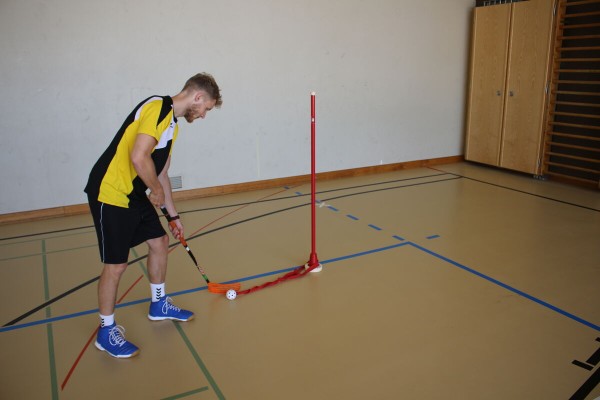
The participant uses the floorball stick to hit the ball clockwise and anti-clockwise around the stake with forehand and backhand strokes.
Variant:
If the ball is only attached with a ribbon (shorter pendulum), the exercise becomes more difficult.
►Rhythmisation skills, reaction skills
1 stake
2 game ribbons
1 floorball stick
1 floorball ball
Post setup:
A floorball ball attached to two linked game ribbons is placed loosely around a stake.
Dribble artist
Coordination exercises
Partner work
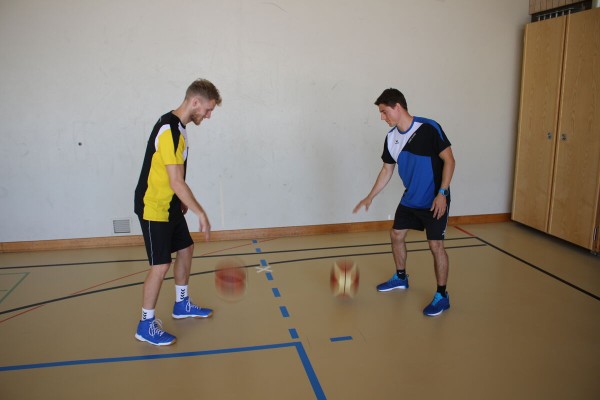
One participant bounces a rhythm with the (basket)ball, the second participant tries to copy the rhythm at the same time.
Variant I:
The imitator bounces twice or half as fast.
Variant II:
Perform the exercise alone with two (basket)balls, bouncing with one hand twice as fast as the other.
► Rhythm skills
2 basketballs
Duel
Coordination exercises
Individual work
Two participants stand on the same slackline at the same time and try to stay up longer than their opponent. Who has 5 points first?
Easing:
Another participant sits in the centre of the slackline.
Heavier:
The participants each hold one end of a skipping rope and try to unbalance the other by pulling; the participants try to unbalance each other with a foam club or a foam ball.
1 Slackline
Dunking
Coordination exercises
Individual work

The participants jump onto the mini trampoline with the basketball in their hands and try to sink the ball into the basket with a basketball shot or even a "dunk".
► Rhythmisation skills, differentiation skills, orientation skills
1 mini-trampoline
1-2 soft mats (large)
4-6 soft mats (small)
1 basketball
Post set-up:
Place the large soft mat(s) under a basketball hoop and set up a mini-trampoline in front of it. For additional safety, place small soft mats around the large soft mat(s).
First steps
Coordination exercises
Individual work
Once you have mastered the basic position, you can try your first steps. It is important to feel the strap with the forefoot before putting the whole foot down. This means you don't have to look at the strap to know where it is. Before you remove the back foot from the strap, you should place it on your toes to shift your centre of gravity to the front foot.
Easier:
Stretch the slackline tightly over a short distance (3-5m); help a partner by holding their hand (always go with the balancing movement and only stabilise when the slackliner is almost falling).
Harder:
Walk backwards; stretch the slackline over a long distance.
1 Slackline
Buttock rocker ► buttbounce
Coordination exercises
Individual work
Fasten the slackline over a long distance (12-15m) at a height of approx. 1m. Sit in an upside-down position so that your eyes and shoulders are aligned with the end point. From this position, rock downwards and upwards, with the momentum coming from the arms. You can touch the ground with your feet, but you should not actively push off, as the energy should come from the slackline.
Lighten the load:
Help a partner by holding their hand; a helper pushes the slackline down slightly while bobbing.
1 Slackline
Straddle jump
Floor and apparatus gymnastics






Frontal run-up onto the mini trampoline (from the long bench), one-legged horizontal jump from the run to the two-legged jump on the trampoline vertically into the air.
Grab jump:
Launch with arm pull forwards upwards, legs stretched out as horizontally as possible forwards after the push-off and touch the feet with the hands (if mobility allows). Extend the body again and come to a safe stance.
The participants practise the form of movement independently using series pictures or based on the demonstration of the exercise by the sports leader. The instructor (or a partner) gives feedback, provides support and checks that the exercise is being performed correctly.
1 mini-trampoline
1 long bench (possibly to mark out the run-up)
2 soft mats (large)
5 soft mats (small)
1 row
Straddle jump / squat jump
Floor and apparatus gymnastics












Frontal run-up onto the mini trampoline (from the long bench), one-legged horizontal jump from the run to the two-legged jump on the trampoline vertically into the air.
Grace jump:
Jump off with arm pull forwards, stretch your legs as horizontally as possible forwards after the push-off and touch your feet with your hands (if your mobility allows it). Extend your body again and come to a safe standing position.
Squat jump:
Jump off with your arms pulled forwards, squat your legs (pull your knees towards your chest) and grasp your knees with your hands. Release the squat position and extend the legs to a safe standing position.
The participants practise the movement form independently using series pictures or based on the demonstration of the exercise by the sports instructor. The instructor (or a partner) gives feedback, provides support and checks that the exercise is being performed correctly.
1 mini-trampoline
1 long bench (possibly to mark out the run-up)
2 soft mats (large)
5 soft mats (small)
2 row pictures
Basic position
Coordination exercises
Individual work
Before attempting the first steps, you should be able to stand on the slackline on just one leg for 5-10 seconds. This has the advantage that you can balance with the second leg. Both the left and right leg must be trained.
Pay attention to the following points:
- Looking forwards;
- Arms above shoulder height;
- Feet straight on the slackline;
- Knees slightly bent;
- Hips upright.
Easing:
Perform the exercise close to the attachment; stretch the slackline taut over a short distance (3-5m); sit a partner in the middle of the slackline to dampen the initial shaking; help a partner by holding their hand (always go with the balancing movement and only stabilise if the slackliner is about to fall).
Hardening:
Cross your arms (in front of your stomach, behind your back or over your head)
1 Slackline
Half turn
Coordination exercises
Individual work
In the starting position, the front foot is turned inwards and the back foot is straight on the band. Your body weight is on the front foot. Now turn the back foot 180 degrees and simultaneously change your gaze in a quick movement (similar to a pirouette).
Lighten up:
Help a partner by holding their hand (always go with the balancing movement and only stabilise if the slackliner is about to fall).
1 Slackline
Handstand with roll-off
Floor and apparatus gymnastics











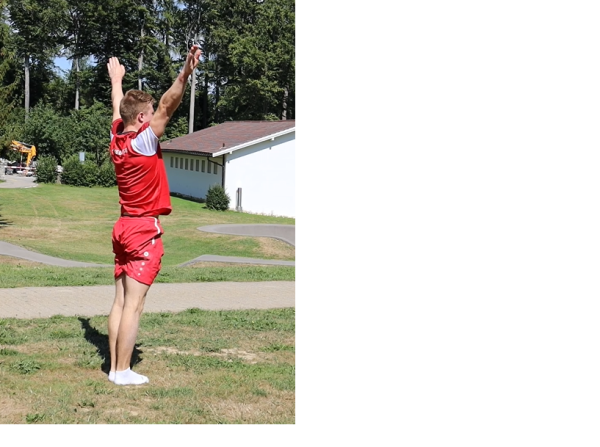
Start in an upright position, swing the arms and swing leg forwards, place the hands wide in front, push off with the standing leg, close the legs to stretch the whole body in a handstand (body tension), look down, bend the arms and hips, bring the chin to the chest, roll over the neck and back, squat the legs, stand up from the seat (without using the hands) to a safe standing position.
Variant:
Practise handstand against a wall beforehand, then with the support of a partner (holding the legs).
The participants practise the movement form independently using series pictures or based on the demonstration of the exercise by the instructor. The sports instructor (or a partner) gives feedback, provides support and checks that the exercise is being performed correctly.
4 soft mats (small) ► indoor version
1 row
outdoor:
turf field
squat
Coordination exercises
Individual work
Standing upright, place the front foot straight and the back foot with the forefoot on the slackline (about one foot length apart). In this position, bend your knees until you can sit with your buttocks on your heels.
Easier:
Perform the exercise close to the attachment.
Harder:
Touch the slackline with one hand (line grab); stand up again from the squat, take a step forwards and squat down again (other forefoot).
1 Slackline
Squat jump
Floor and apparatus gymnastics






Frontal run-up onto the mini trampoline (from the long bench), one-legged horizontal jump from the run to the two-legged jump on the trampoline vertically into the air.
Squat jump:
Launch with arm pull forwards upwards, squat with the legs (pull the knees towards the chest) and grasp the knees with the hands. Release the squat position and extend the legs to a safe standing position.
The participants practise the movement form independently using series pictures or based on the demonstration of the exercise by the sports instructor. The instructor (or a partner) gives feedback, provides support and checks that the exercise is being performed correctly.
1 mini-trampoline
1 long bench (possibly to mark out the run-up)
2 soft mats (large)
5 soft mats (small)
1 row
Juggler
Coordination exercises
Individual work
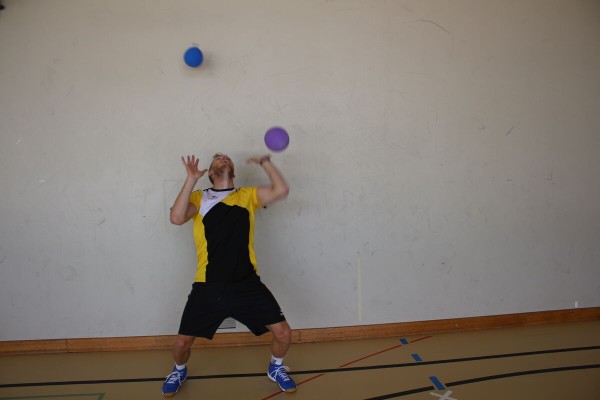
Hold two, three or more balloons in the air at the same time by flapping them with your hands without one balloon falling to the ground.
Variant I:
Hold balloons or balls/shuttles in the air with a tennis or badminton racket.
Variant II:
Hold juggling scarves in the air by plucking them.
8 balloons
2 badminton/tennis rackets
4 badminton shuttles/balls
6 juggling cloths
Juggler
Coordination exercises
Individual work
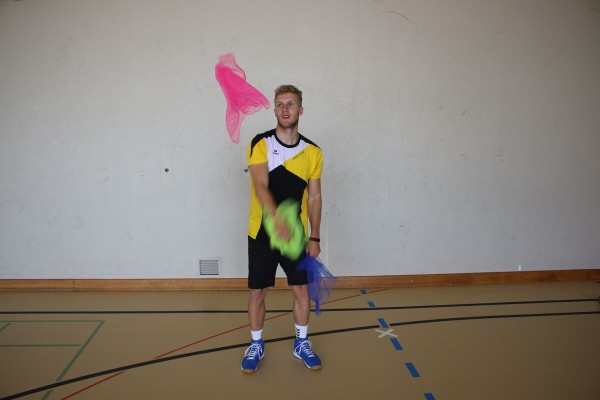
The participants try to juggle with different utensils:
- Juggling one-handed with 2 balls or two-handed with 3 balls (tennis balls, foam balls, floorball balls, possibly even frisbees). Also possible standing on a balancing board.
- Holding juggling scarves in the air.
- Holding a badminton shuttle with the racket in the air while sitting down and standing up. Perform half and full body rotations while juggling. The same exercise can be performed with the Indiaca.
- Throw the foam ball into the air or against a wall and catch it with the frisbee. Throw the foam ball to each other in pairs and catch it with the frisbee.
Make it easier:
Juggling can be practised on an inclined surface (e.g. door of the equipment room/garage door; small mats set up at an angle). The balls are not thrown straight up into the air, but onto the sloping surface. This gives the participant more time to learn the basic movement.
► Differentiation ability, rhythmisation ability, reaction ability
3 tennis/unihockey/smolball balls, throwing discs, juggling cloths
1 Indiaca
1 badminton racket incl. badminton shuttle
1 balance board
Door of the equipment room/garage door ►Facilitate the exercise
Kastensurfer
Coordination exercises
Individual work

The participant tries to keep their balance while standing on the unstable box lid.
► Balance ability
1 vaulting box top
3-4 basket/medicine balls
Post structure:
One vaulting box top is placed on three to four medicine or basketballs
King of the line
Coordination exercises
Individual work
Two participants stand on the same slackline. The one who manages to stay up longer receives a point. Who has 5 wins first?
Easier:
Another participant sits in the centre of the slackline.
Easier:
The participants position themselves closer together in the centre of the slackline.
1 Slackline
Kneecap ► kneedrop
Coordination exercises
Individual work
Position your front foot straight and bend your leg. With your back leg, hook your shin onto the strap and try to push your knee under the slackline.
Lighten the load:
Perform the exercise close to the attachment.
Harden the load:
Touch the slackline with one hand (line grab); stand up again from the kneedrop position, take a step forwards and perform another kneedrop (different forefoot).
1 Slackline
Headstand
Floor and apparatus gymnastics



A triangle is formed on the floor using the head and both hands. The larger the area of the triangle (i.e. the further apart the vertices are), the greater the stability. The body is stretched vertically upwards (bend the legs first, then bring them upwards).
The participants practise the movement form independently using series of pictures or based on the exercise being demonstrated by the instructor. The instructor (or a partner) gives feedback, provides support and checks that the exercise is being performed correctly.
2 soft mats (small) ► indoor version
1 row
outdoor:
turf field
Orientation artist
Coordination exercises
Partner work
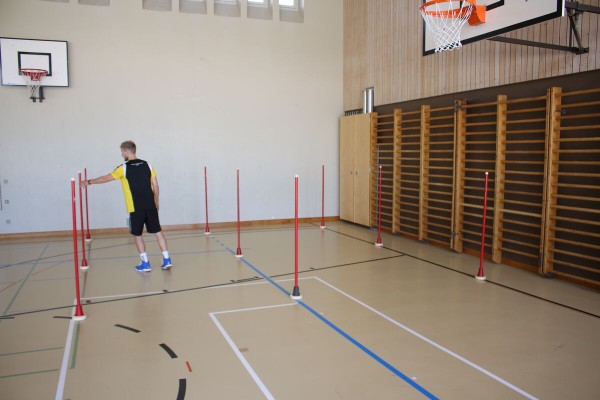
One participant gives their partner a route to run around the stakes to the opposite side. With their eyes closed, they try to run the specified route. After feedback on the execution of the exercise, the roles are swapped.
Variant:
Individual work: the participant imagines a route for themselves and tries to complete it with their eyes closed (blind route).
►Orientation skills
9 stakes
Post setup:
Place the stakes in a rectangle (3x3).
Passing game
Coordination exercises
Partner work

Two participants stand opposite each other on the thin side of a long bench at a distance of approx. 4-5 metres and play badminton (or Indiaca).
► Differentiation ability, orientation ability
Per group of 2:
2 badminton rackets
1 badminton shuttle
1 Indiaca
2 long benches
Post setup:
Place two long benches parallel to each other with a distance of approx. 4-5 metres and the narrow side facing upwards.
Passing game
Coordination exercises
Partner work
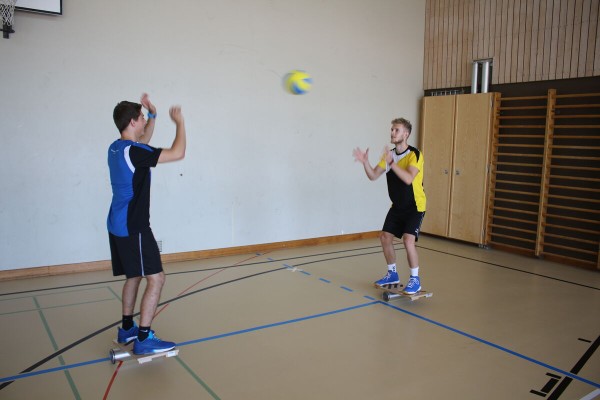
The participants stand approx. 3 metres apart and throw a volleyball at each other. Both participants stand on a medicine ball or a balance board and try to keep their balance. If the exercise is too difficult, the participants can support each other (hold/secure) and first try to stand reasonably safely on the medicine ball/balance board.
► Balance skills
2 balance boards/medicine balls
1 volleyball
Passing game
Coordination exercises
Partner work
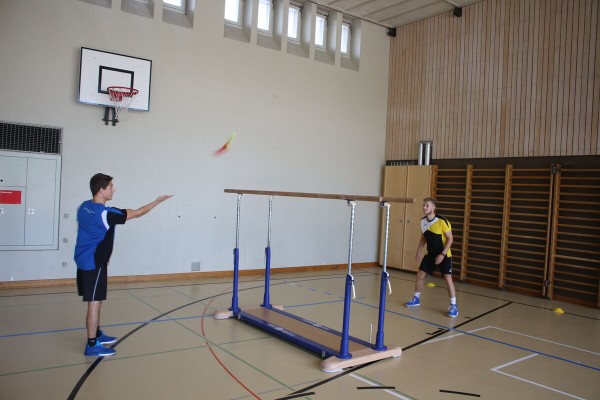
The participants pass an Indiaca to each other with the palms of their hands over the raised bar. They try to play right and left and keep the Indiaca in the air for as long as possible.
Variant:
Game (competition) for points.
► Differentiation ability, reaction ability
1 parallel bar
1 Indiaca
4 marking cones (optional) ►Playing field marking
Post set-up:
Fix the uprights of a parallel bar at a great height. Optionally mark a playing field around the bar using cones
Passing game
Coordination exercises
Partner work

The participants stand opposite each other in two marked rectangles with a certain distance between the fields (approx. 4-5 metres for Indiaca/badminton; approx. 8-10 metres for speedminton). The participants play an Indiaca with the palms of their hands or a shuttle with their rackets. When playing with the Indiaca, participants try to play with the right and left. The aim is to keep the Indiaca/shuttle in the air for as long as possible.
Variant:
Game (competition) for points.
► Differentiation ability, reaction ability
8 marker cones/cups
1 Indiaca
Post set-up:
Mark out two playing fields using cones.
Passing game
Coordination exercises
Partner work
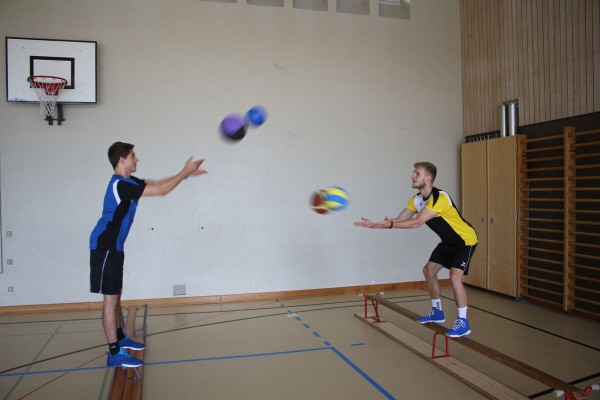
Two participants stand opposite each other on the narrow side of a long bench and pass two different balls to each other at the same time.
Variation:
Plays via the floor.
► Balance skills, differentiation skills
2 long benches
1 football
1 volleyball
1 softball
1 floorball
1 tennis ball
1 medicine ball
1 handball
1 lightning ball
Post setup:
Place two long benches parallel to each other with a distance of approx. 2-3 metres between them.